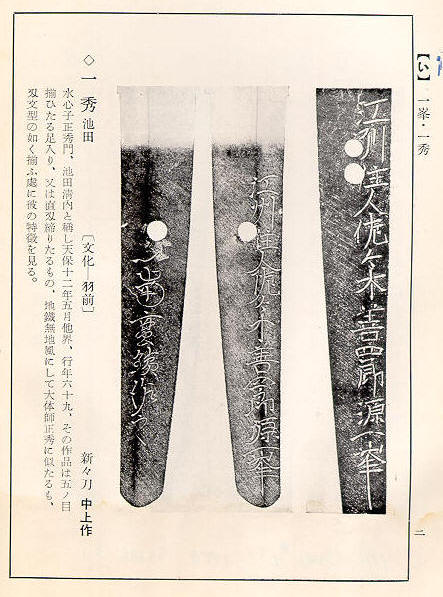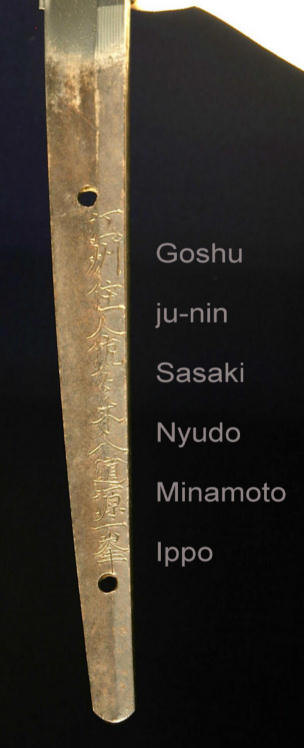“Immortal Sword” with Keiki*
Personified and described in the tester’s own words – to possess immortality.
With “Tokubetsu Saidan”, Rare 3 Body Cutting Test, 320 + Years Old
Blade personally named by the tester, “Fujimi Hairu”*
Tokubetsu Kicho Ninteisho by the N.B.T.H.K.
*Keiki – Official Definition from Hawley’s: a physic feeling thought to be generated by the living spirit of the blade…
* Fujimi definition – forever, perpetual, never die…
Article By: David E. J. Pepin & Tim Pepin, © 2008

“Ipp?” worked in Omi Province in 1648 in the Ishido School. His blades are rated Wazamono – “superb sharpness”…The works of Sasaki Ipp? Shodai (1st Generation) are very rare and many of those that are seen today are the works of second generation, as they worked together (2nd Gen was active around Enpo to Tenna Eras (1673-1681 AD), both rated as Jo Saku (Superior Made). It is very difficult to discern the difference between Sasaki Ipp? Shodai (1st Generation) and Sasaki Zenjiro (2nd Generation) as many of their blades are with very similar characteristics. Sasaki Ipp? Shodai blades are known for their width and almost luminous luster.
There is another sword by Ipp? that was presented by General Douglas Mac Arthur to FBI Director J. Edgar Hoover in 1945. It was a Katana (mounted in Military fittings), signed by “G?sh? Jy?nin Sasaki Ny?d? Minamoto Ipp?”. The sword came with a 25 page dossier, which documented the swords history and provenance, it also included a copy of a document from the national archives documenting the presentation, dated November 21, 1945, and also a copy of a photo showing the sword hanging in the Hoover home.
Omi Province
A old text records that a group led by Sukenaga went to Omi Province from Bizen Province during the late Muromachi Period, however there are no works of these smiths remaining today, nor are there any swordsmiths who are descendants of these smiths.
The Ishido School (which originated at the Sekido Temple in Omi Province) sent forth many swordsmiths to various sections of the country to open additional branches of The School, however, there were very very few of those that remained… Sasaki Ippo being the one of those that attained fame and skill. The Sasaki Ippo (Ishido School) group worked in approx 1648 AD through 1681 AD. The Ishido school smiths were best known for their ability to produce swords in the Bizen tradition of the Ichimonji School and also worked in the Shinto tradition.
The Cutting Test
The Cutting Test was performed at Bushu (Musashi Province), Itomachi (City, District), Kiru (Cut at place) during the middle of December 1687 (320 + years ago). The tester wielded the sword very quickly with great strength that it effortlessly struck completely through all three bodies in one easy motion with great speed. During the cutting test he experienced denko (a brilliant flash of celestial light similar to that of lighting). These statements are inscribed (in Japanese) with the remainder of the cutting test “SAIDAN” data. The remainder of the test details are captioned with the images of the nakago. It is also said that some person’s can easily site the feeling of “Keiki” ( A psychic feeling of the presence of another person) when handling a blade such as this.
The blade possess the following features, and (translated) statements; by the tester “Yoshisada”. The personification of the blade by giving it the name, Fujimi; indicates that its abilities are “IMMORTAL”, and can never be lost (never die). “Hairu”, means that this has been embodied into the blade. It is believed in the Japanese Culture that many Japanese Swords have their own spirit. It is very well known amongst many collectors that some have experienced this “IMMORTAL LIFE” almost to a sense where they could feel the hairs on their neck raise up – as if the spirit of the Japanese Sword is actually present.
To encounter a (Tameshigiri or Saidan) blade with these attributes (especially as stated by the sword tester) is one of the rarest occurrences in the realm of the Japanese Sword.

History of Tameshigiri
The oldest “Tameshigiri” documented in Japanese history goes back to Heian era (794-1184 AD). Two swords were made by renowned swordsmiths at that time by order of Tada Mitsunaka. One was called “Hige Kiri” since it cut through beard and the other was called “Hiza Maru” since it cut through knee joint of the bodies of executed criminals used for test cutting. Both swords were designated as family treasures of Genji clan. The story was cited in the first chapter of “Heike Monogatari (A Story of Heike Clan)” and several other sword specialty books written during the following centuries. However, who made these swords and who actually tested them is not clear. Neither sword exists any longer. During Kamakura Era (approx 1185-1332 AD) several stories about Tameshigiri using stone as target evolved. Stones and rocks that were said to be tested with swords made by Kanenaga, Munechika and others still exist. However, most of these stories are fictional legends without reliable documentation. See below to view a cutting test chart.
N.B.T.H.K. Origami – K?shu Tokubetsu Kich? Ninteisho

~ ~ ~
Certification issued Showa 53, April 4th 1978
Length 2 shaku 3 sun 1 bu
Katana mei: G?sh? Jy?nin Sasaki Ny?d? Minamoto Ipp?
(Kinz?gan Teiky? 4 (1687 AD) Mid winter.
N.B.T.H.K. Chairman Honma Junji
States Origami was issued to Tada Tar?
~ ~ ~
N.B.T.H.K. Origami – K?shu Tokubetsu Kich? Ninteisho started in Sept of 1973 (Showa 48) and was issued up until 1979 (Showa 54). K?shu Tokubetsu origami were issued at the main office and local branches. K?shu Tokubetsu Kich? can be translated to mean “superior of the especially precious”. This type of N.B.T.H.K. origami is commonly called a “blue paper”. It was the highest rank below Juyo throughout its use.
Other Ippo works listed in Fujisho’s








 This is the most common region cut for multiple body cutting tests.
This is the most common region cut for multiple body cutting tests.
This shows example how two bodies were stacked before the cutting test – a third body would be added in the same manner.
Click first image to scroll through larger size…
[rl_gallery id="1259"]
Article By: the late David E. J. Pepin & Tim Pepin 2008
Copyright Samuraisword.com
Return to Articles
This Sword is not available for purchase.
If you wish to purchase a Japanese Sword please view our Nihonto for sale page or contact us directly via email or contact us @ 1(608) 315-0083 any time , please include specifics of what you seek, i.e.: Katana, maker, era, price range etc.


